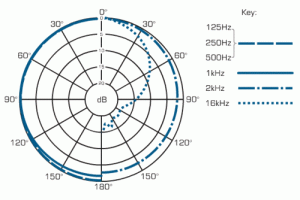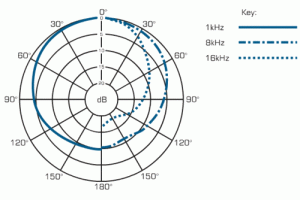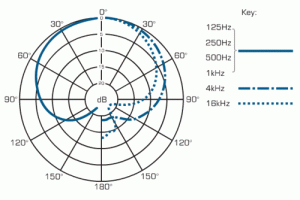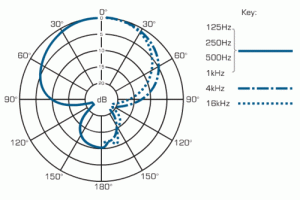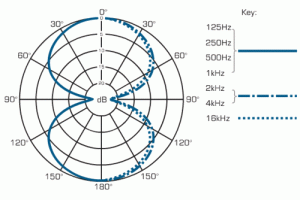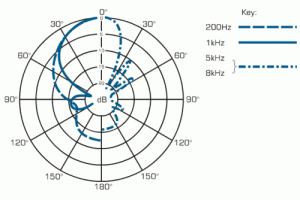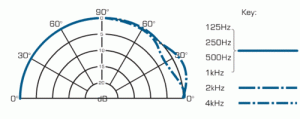Polar Pattern
The Polar Pattern of a Microphone describes its directional sensitivity. The main family of patterns is a continuous spectrum between omni and bi-directional (figure-of-eight). Thus their titles are somewhat arbitrary, often overlap and, perversely, in most cases they are best defined by their ability to reject sound. Polar Patterns are generalised – they give an indication of the directional discrimination of the microphone but they will almost certainly vary across the frequency range. For most microphones the pattern is a three-dimensional one – completely symmetrical around the main axis.
It is important to realise that the polar response of a microphone is inherently connected to various other properties including sensitivity to wind, handling noise, proximity effect and frequency response. Thus a sub- or wide cardioid will be less directional than its cardioid sibling but have a better bass response and less proximity effect.
Polar Patterns are normally displayed using polar diagrams with a family of superimposed, normalised polar curves.
Contents
1 Omnidirectional
2 Cardioid
2.1 Sub and Wide
2.2 Cardioid
2.3 Super and Hyper
3 Bi-directional
4 Rifle
5 Hemispherical
Omnidirectional
An omnidirectional microphone has, in general terms, an equal sensitivity in all directions. In practice this only holds true over part of the frequency range – at high frequencies the physical size of the microphone acts as an acoustic shadow and narrows the pattern to a more directional one.
Cardioid
Sub and Wide
Subcardioids or wide cardioids are versions of hypocardioid (less than cardioid) patterns – slightly more directional than an omni but no more than that. They are most easily distinguished by their rear sensitivity – anything from 2-18 dB lower compared to their front sensitivity.
Cardioid
Cardioid microphones are typified by having a high rear rejection at 180° – ideally infinite but usually >20 dB.
Super and Hyper
Supercardioids are a variant of a hypercardioid (and often not distinguished from them) but usually reckoned to reject sound best at 150°.
Hypercardioids start to acquire some of the characteristics of a bi-directional microphone in that they have some sensitivity to the rear. However they reject sound well at about 120°.
Hypercardioids are also sometimes categorised by their rear lobe (180°) sensitivity.
Bi-directional
Bi-directional microphones display ideal Pressure Gradient properties and reject sound almost perfectly at 90°.
Rifle
Short and long rifle, or shotgun, microphones are really hypercardioids that have been fitted with an Interference Tube to increase the directionality at medium to high frequencies. This can give significant forward gain but often at the cost of a rather messy high frequency polar pattern, sometimes referred to as a lobed response. These rear lobes can give rise to unpleasant off-axis colouration effects.
Hemispherical
Hemispherical patterns arise from omni microphones placed against a flat surface – boundary or Pressure Zone Microphones.
The same trick can be applied to directional capsules but the results often lead to rather strange patterns and can suffer significant colouration.

